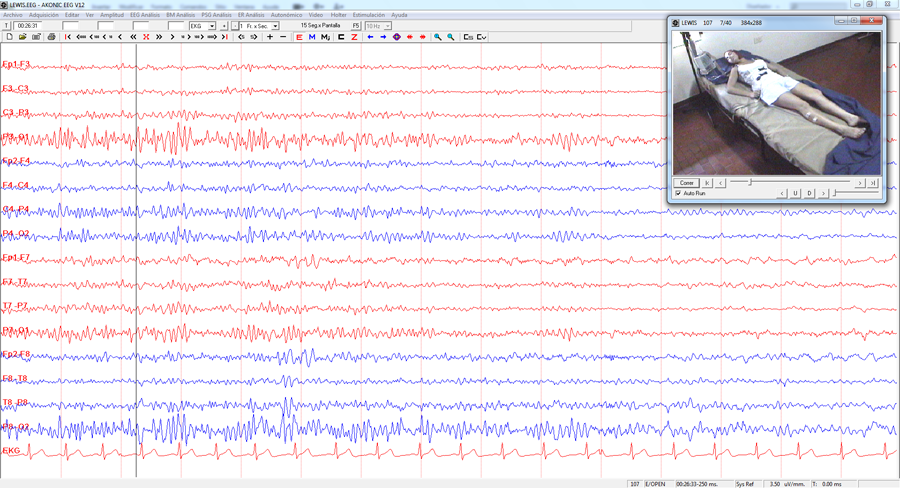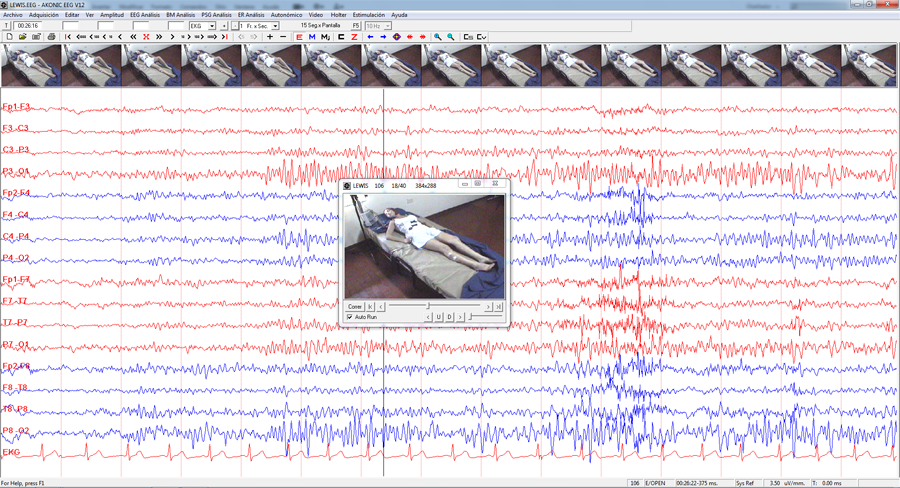Digital electroencephalographs in Buenos Aires City
digital
At Akonic SA, you will not only be able to find digital electroencephalographs, but many other digital equipment, among which are the following:
BIO-PC system
The BIO-PC is the most powerful system. Its technical specifications are:
Security:
Electrical safety according to EN60601-1 standards.
Required operating system:
Windows XP/NT/2000/Vista/Seven/Windows 8.
System caracteristics:
- Line input: 90/240 VAC @ 50/60 Hz.Fuses: 1A - type T (slow blow).Temperature: 5 - 30 °C.Relative humidity: < 50% non-condensing.Self-diagnostics: calibration generator. Electrode impedance measurement. A/D resolution: 16 bits. Number of channels: 32 channels + system reference + 7 ground inputs. EEG channels:
Input impedance: > 20 MOhm.
Hardware low frequency filter: 0.5 Hz.
Hardware high frequency filter: 100 Hz.
Hardware Notch Filter: 50/60 Hz.
Digital Low/High/Notch Filter: User selectable.
Sensitivity: 1 to 128 µV/mm. User selectable.
CMRR: > 100 dB a 50/60 Hz.
- Canales EMG / EP:
Input impedance: > 20 MOhm.
Low/High/Notch Filters: User selectable.
Hardware low frequency filter (Hz): 0.15 - 0.5 - 1.5 - 5 - 10 - 30 - 100 - 300.
Hardware high frequency filter (Hz): 10000 - 5000 - 3000 - 2000 - 1000 - 300 - 100 - 30.
Hardware Notch Filter: 50/60 Hz.
Sensitivity (µV): User selectable.
CMRR: > 100 dB a 50/60 Hz.
- EKG channels:
Input impedance: > 20 MOhm.
Hardware low frequency filter: 0.15 Hz.
Hardware high frequency filter: 25 Hz.
Hardware Notch Filter: 50/60 Hz.
Sensitivity: 1/128 µV/mm. User selectable.
CMRR: > 100 dB a 50/60 Hz.
- FA, Belt1 and Belt2 channels:
Input impedance: > 20 MOhm.
Hardware low frequency filter: 0.07 Hz.
Hardware high frequency filter: 100 Hz.
Hardware Notch Filter: 50/60 Hz.
Low/High/Notch Digital Filters: User selectable.
Sensitivity (max): 50 µV/mm. User selectable.
CMRR: > 100 dB a 50/60 Hz.
- Canal MIC:
Input impedance: > 20 MOhm.
Hardware low frequency filter: 15 Hz.
Hardware high frequency filter: 300 Hz.
Hardware Notch Filter: 50/60 Hz.
Sensitivity: 1/128 µV/mm. User selectable.
CMRR: > 100 dB a 50/60 Hz.
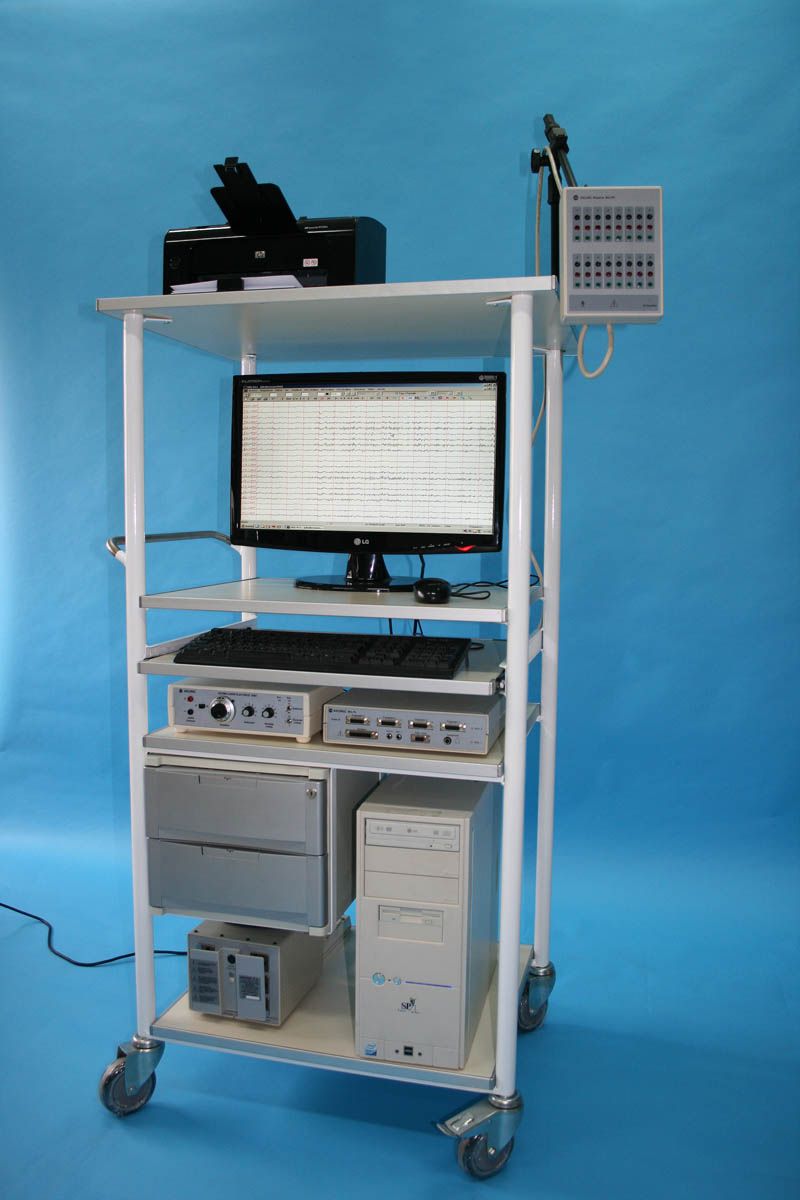
- External channels (Ext1 - Ext2):
Use: oximetry / pH / CPAP pressure / other DC signals.
Input impedance: 220 KOhm.
Hardware low frequency filter: DC.
Hardware high frequency filter: 70 Hz.
Low/High/Notch Digital Filters: User selectable.
Maximum input voltage: ±4 volts.
Input Voltage Range: User Selectable.
Stimulators:
- Audio stimulator: click/masking - tone/masking.Checkerboard stimulator (pattern reversal).Electrical stimulator.SLD photostimulator.SLD-W photostimulator.
Self-diagnostics:
- Calibration generator. Online electrode impedance measurement.
You can download the brochure by clicking here.
NeuroTrace - mini PC
The NeuroTrace - mini PC is the most practical system. It is a modern and effective equipment for electroencephalography, video EEG/PSG, brain topographic mapping, polysomnography and Holter studies. The NeuroTrace model was created in order to improve the quality of work and at the same time facilitate its transfer, due to its reduced dimensions and low weight.
The technical specifications of the NeuroTrace - mini PC system are:
Security:
- Electrical safety according to 93/42/EEC, EN60601-1, EN60601-1-1, EN60601-1-2, EN60601-1-4 and EN60601-2-26 standards. Patient isolation: 1,500 volts - optocoupler. Connectors safety (32 channels reference 7 grounds).
Required operating system:
- Windows XP/Seven/Windows 8.
System caracteristics:
- Powered by USB.Temperature: 5 - 30 °C.Relative humidity:< 50 % sin condensación.Autodiagnósticos: generador de calibración. Medición de impedancia de electrodos.Resolución A/D: 16 bits.Número de canales: 32 canales + referencia del sistema + 7 entradas de tierra.Canales de EEG:Impedancia de entrada: > 20 MOhm Hardware Low Frequency Filter: 0.5 Hz Hardware High Frequency Filter: 100 Hz Hardware Notch Filter: 50/60 Hz Digital Low/High/Notch Filter: User selectable Sensitivity : 1 to 128 µV/mm. User selectable. CMRR: > 100 dB at 50/60 Hz.
Auxiliary channels (1: EKG - 2: FA - 3: BELT1 - 4: BELT2 - 5: MIC):
- Input Impedance: > 20 MOhm Hardware Low Frequency Filter: 0.07 Hz Hardware High Frequency Filter: 100 Hz Hardware Notch Filter: 50/60 Hz Digital Low/High/Notch Filters: selectable by the user. Sensitivity (max): 50 µV/mm. User selectable. CMRR: > 100 dB at 50/60 Hz.
Auxiliary channels (6: EMG1 - 7: EMG2 - 8: EMG3 - 9: EMG4):
- Input Impedance: > 20 MOhm Hardware Low Frequency Filter: 3.5 Hz Hardware High Frequency Filter: 100 Hz Hardware Notch Filter: 50/60 Hz Low/High/Notch Digital Filters: Selectable by the user. Sensitivity (max): 5 µV/mm. User selectable. CMRR: > 100 dB at 50/60 Hz.
Ext1 - Ext2 channels:
- Use: oximetry / pH / CPAP pressure or other DC signals. Input impedance: 50 KOhm. Low frequency filter: DC. Low/high/Notch digital filters: user selectable. Maximum input voltage: ±5 volts. Input Voltage Range: User Selectable.
SLD USB photo stimulator:
- High brightness LEDs, fixed intensity of 90 candelas. Stimulation frequency selectable by the user from 0.5 to 30 Hz. Powered from USB port.
Photo stimulator SLD-W:
- High brightness LEDs, fixed intensity of 90 candelas. Stimulation frequency selectable by the user from 0.5 to 30 Hz wireless. Powered by a 9 volt Panasonic P-9SPA battery (Ni/Cd 120 mAh 9 volt) or similar.
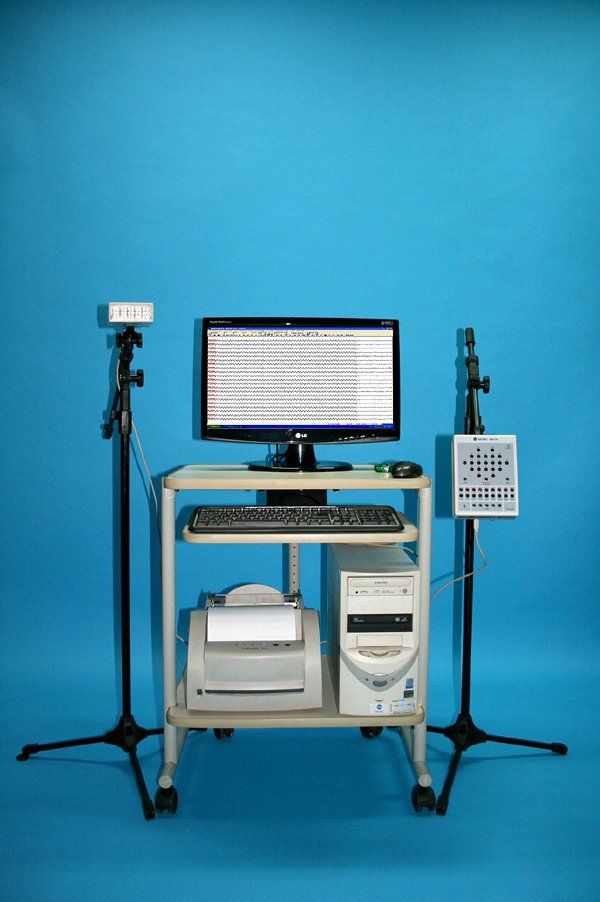
Thermistor Airflow Sensor (ATS):
- Power from the equipment.
Airflow Pressure Sensor (APS):
- Power from the equipment.
Software:
- Electroencephalography V12.Polysomnography V12.Cerebral topographic mapping V12.Electroencephalography V11.Polysomnography V11.Cerebral topographic mapping V11.Video EEG/PSG V12 / V11.Encephalographic Holter (optional hardware) only V12.
You can download the brochure by clicking here.
The software with which these teams work are:
Evoked Potentials Software V11
PE V11 software is a Windows based software for data acquisition, analysis and reporting. Their characteristics are:
Required operating system:
- Windows XP/Seven/Windows 8.
Required hardware:
- BIO-PC™ system.
Software Features:
- Online impedance measurement.Digital filters.Direct and average presentation.Unlimited number of traces on screen.Automatic marks with manual correction.FFT (Fast Fourier Transformer) analysis.Quick menus and easy review of the study.Cursors for latency and amplitude measurements. .Frequency of stimulation by software (plateau, rise-decay, tones and polarity of the stimulus).Selection of the color of the trace.High quality printing with all types of printer.Online help.Graphic screen capture as .bmp files.User's Manual user submitted in .pdf format.
Full PE Tests:
- Short, medium and long latency auditory PE. Trunk PE (BERA). Cortical auditory PE (CERA). Cognitive auditory PE. Motor PE. Cognitive PE. Electrocochleography. Lower and upper limb somatosensory PE. Electroretinography. Flash visual PE .PE visuals by checkerboard (pattern reversal).PE visuals with glasses (Goggles).PE cognitive visuals (flash, pattern, goggles, bmp).
Technical specifications:
- Number of channels: 2, 4 and 8 channels. High frequency filter (Hz): 10000 - 5000 - 3000 - 2000 - 1000 - 500 - 100 - 30. Low frequency filter (Hz): 0.15 - 0.5 - 1.5 - 5 - 10 - 30 - 100 - 300. Notch filter: 50/60 Hz. Sensitivity: 1 - 2 - 5 - 10 - 20 - 50 - 100 µV. Input impedance: > 20 MOhm. CMRR: > 110 dB at 50/60 Hz. Noise level: 0.7 µV.
Stimulators:
- Click/masking.Tones and P-300 (250-500-1000-1500-2000-3000-4000-6000-8000 Hz tones).Binaural, insert earphone.Checkerboard (pattern reversal) .Flash: Super Light Diodes (leds).Goggles.BMP images.Electrical stimulator (CC).
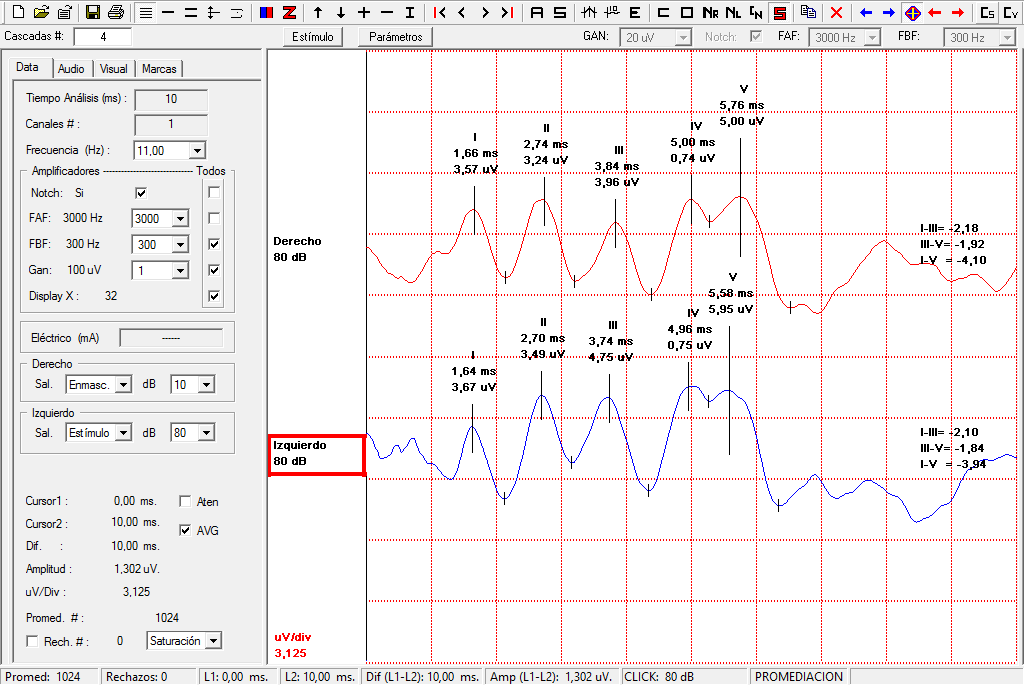
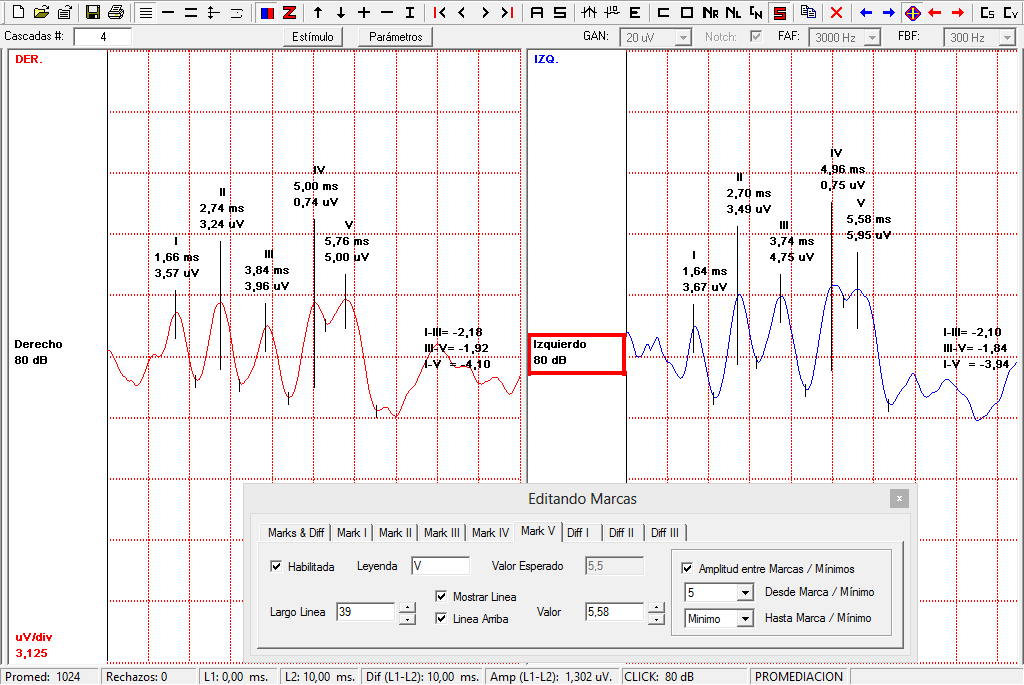
Available applications:
- Digital EEG.Digital polysomnography with analysis.Topographic brain mapping (qEEG).FFT analysis.Digital video monitoring of EEG/PSG.Event Related Potentials.Electromyography.Steady state.EEG ambulatory Holter.
You can download the brochure by clicking here.
Electromyography Software V10
Electromyography V10 Software is a Windows based software for data acquisition, analysis and reporting. Their characteristics are:
Required operating system:
- Windows XP/Seven/Windows 8.
Required hardware:
- BIO-PC™ system.
Software Features:
- Individual selection of high/low frequency filters and channel-by-channel gain.Skin temperature measurement with correction factor.Online impedance measurement.Quick menus and easy review of the study.Cursors for measurements.Pacing frequency by software.Selection of the sound mode. Selection of the trace mode. Skin temperature meter with correction factor (optional). Double foot pedal for "free hands" operation (optional). High print quality with all types of printers. Online help. Graphical screen capture as .bmp files. User manual presented in .pdf format.
Complete EMG Tests:
- Detection EMG.Sensory and motor conduction velocity.Repetitive stimulation.F wave analysis.H wave analysis.Blink reflex.Isolated fiber (optional electrode).Motor potentials.Intraoperative monitoring.Rhizotomy.Somatosensory potentials.
Technical specifications:
- A/D resolution: 16 bits. Number of channels: 2-4-8-16 simultaneous channels. High frequency filter (Hz): 10000 - 5000 - 3000 - 2000 - 1000 - 500 - 100 - 30. Low frequency filter (Hz): 0.15 - 0.5 - 1.5 - 5 - 10 - 30 - 100 - 300.Sensitivity: 2 - 5 - 10 - 20 - 50 - 100 - 200 - 500 - 1000 - 2000 - 5000 - 10000 (µV/Div). Input impedance: > 20 MOhm. CMRR: > 110 dB at 50/60 Hz. Noise level: 0.7 µV.
Transcranial stimulator:
- Constant current (CC). Intensity: 1 - 1000 mA. Programmable pulse duration, number of pulses and pulse spacing.
electrical stimulator:
- Constant current (DC). Intensity: 1 - 100 mA. Duration: 100 - 500 µsec.
Low current stimulator:
- Constant current (DC). Intensity: 1 - 40 mA. Duration: 100 - 200 µsec.
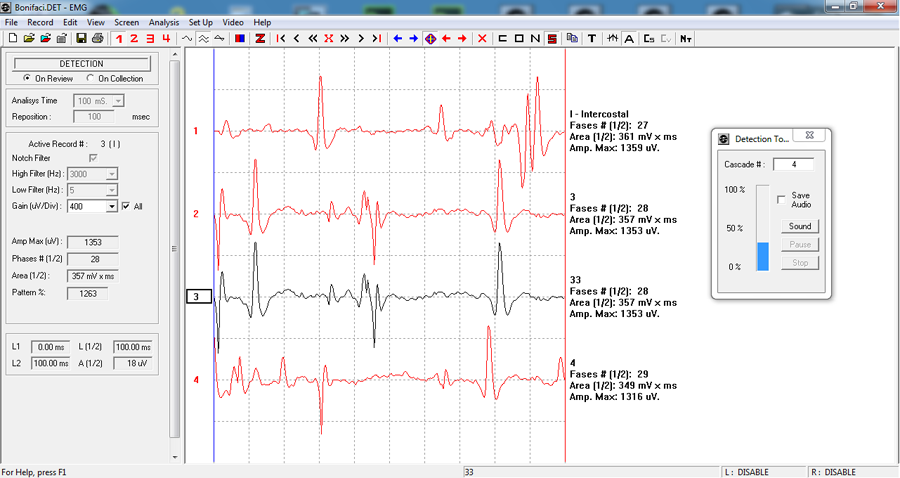
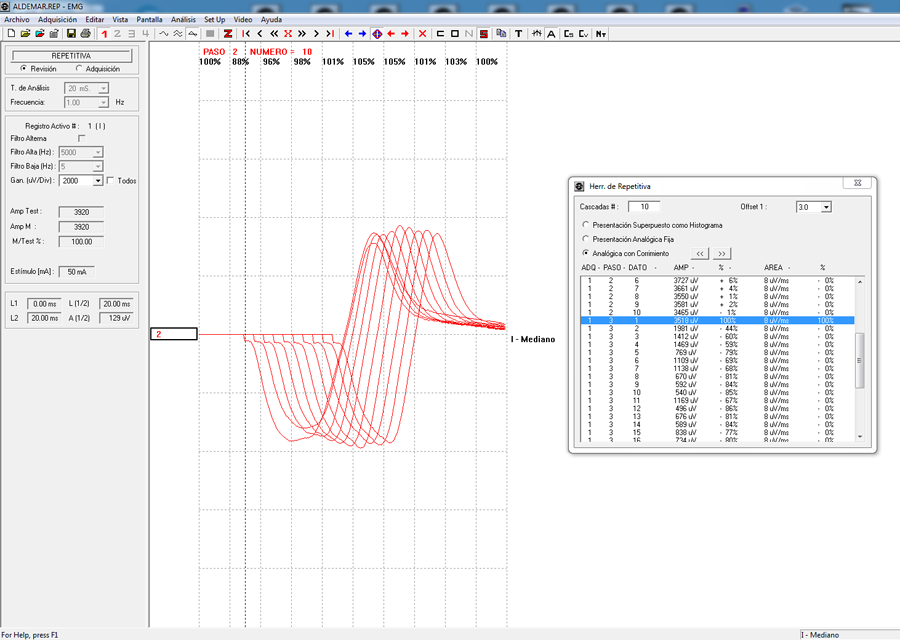
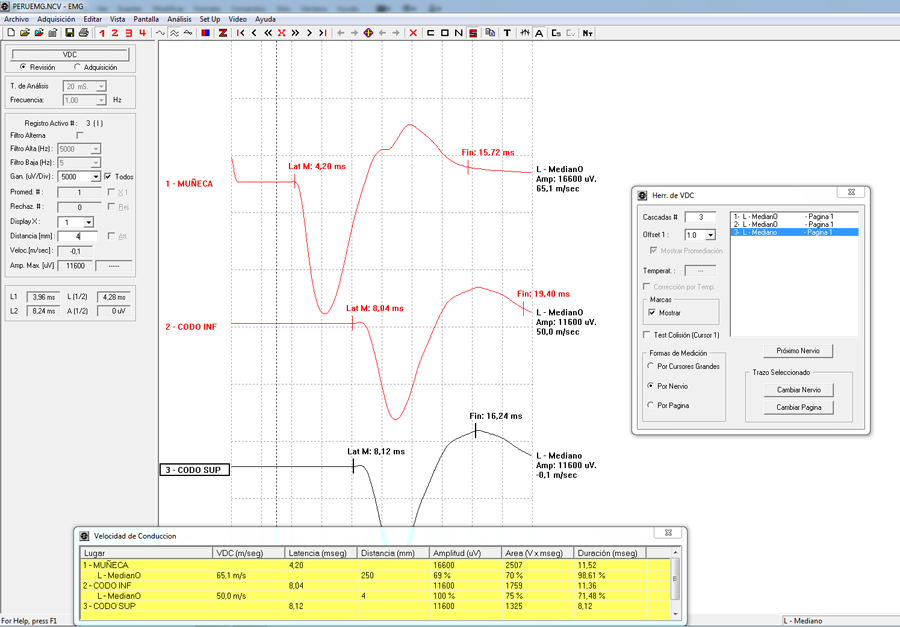
Available applications:
- Digital EEG.Digital polysomnography with analysis.Topographic brain mapping (qEEG).FFT analysis.Digital video monitoring of EEG/PSG.Event related potentials.Evoked potentials.Electronystagmography.Steady state.EEG ambulatory Holter.
You can download the brochure by clicking here.
EEG Software V12
Electroencephalography Software V12 (EEG V12) is Windows based software for data acquisition, analysis and reporting. Their characteristics are:
Required operating system:
- Windows XP/Seven/Windows 8.
Required hardware:
- NeuroTrace™ system (1020 system). BIO-PC™ system (1020-1010 system with 64 channels).
Optional:
- Cerebral topographic mapping.Video EEG/PSG.Encephalographic holter.
Software Features:
- Quick menus and easy review of the study. User-defined patient status and comments. Cursor for measurement of amplitudes, peak-to-peak voltage, initial voltage, time, and frequency. High and low frequency channel-by-channel post-processing digital filters. Paging and seconds per page controlled by software during record review. Visual stimulation and auditory stimulation. Automatic or manual PSG analysis. Body position sensor, ambient light sensor and serial oximeter.Piezoelectric respiratory effort sensors.Online impedance test.Unlimited number of user-configurable assemblies.Monopolar, referential and bipolar reconstruction.Automatic conversion to ASCII and EDF formats.High quality printing with all types of printer.Online help.User manual presented in .pdf format.
Technical specifications:
- A/D resolution: 16 bits. Safety tokens and connector for eletrocap. Number of channels: 21 EEG/EOG channels (up to 64 channels), 1 airflow channel (thermistor or pressure sensor), 2 stress channels respiratory devices, 6 ground inputs, 4 digital display channels and 2 DC auxiliary inputs (oximetry, pH, CPAP pressure, etc.).
Photostimulator:
- Super Light Diods (SLD).Optional: SLDW and wireless photostimulator with rechargeable batteries.Software controlled stimulation frequency: 0.5 to 30 Hz and manual.
Audioestimulador:
- Click or tone (BIO-PC). Intensities and durations controlled by software.
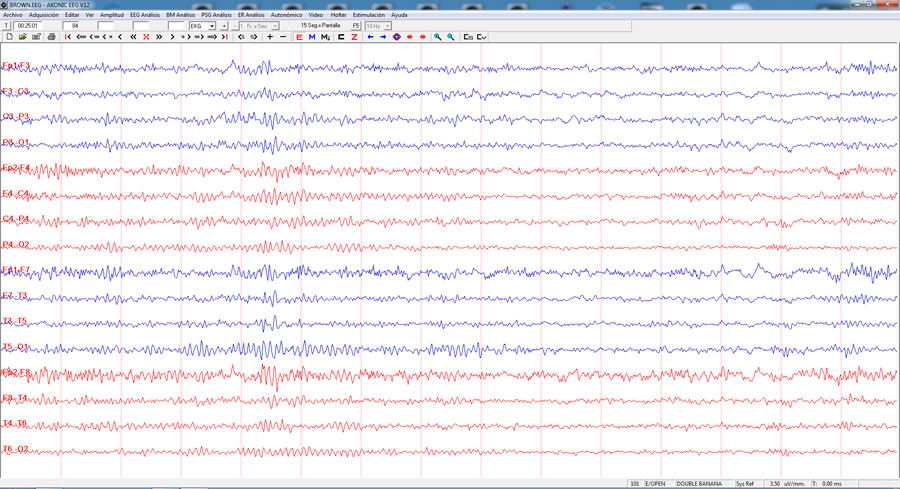

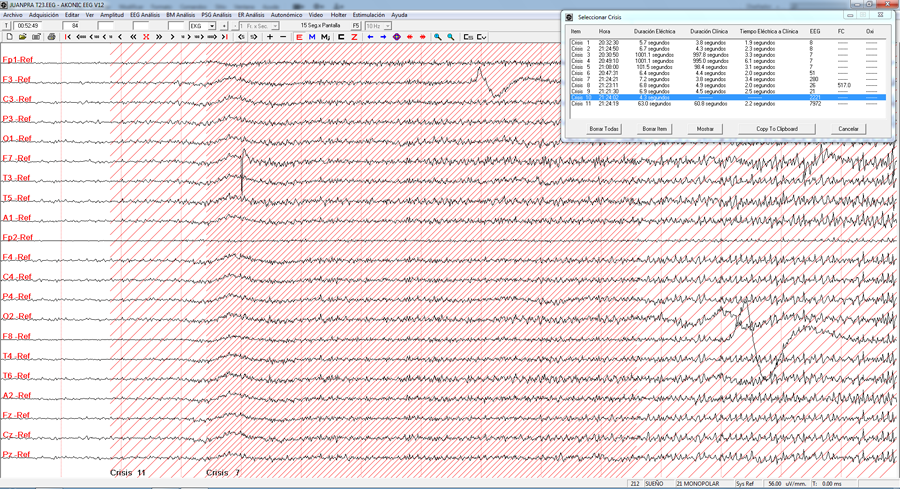
Available applications:
- Topographic brain mapping (qEEG).FFT analysis.Video digital monitoring of EEG/PSG.Event related potentials.Evoked potentials.Electromyography.Steady state.Electronystagmography.EEG ambulatory Holter.
You can download the brochure by clicking here.
V12 Topographic Brain Mapping Software
V12 Topographic Brain Mapping Software is Windows based analysis and reporting software. Their characteristics are:
Required operating system:
- Windows XP/Seven/Windows 8.
Required hardware:
- NeuroTrace™ system. BIO-PC™ system.
Required software:
- Software EEG V12.
Software Features:
- Maps, numerical data and frequency spectra (histograms) in five possible scales:
absolute power.
Relative power per band.
Relative power per channel.
Relative amplitude per channel.
Asymmetry.
- Dynamic mapping for epilepsy (up to 28 maps). Animated mapping. Fourier mapping. Spectral power. Interelectrode brain coherence. Interhemispheric brain coherence. Sample comparison. Z-score analysis with selection of standard deviation. Detection of sharp waves. Comparison between patients and medications. User selectable bands. User selectable palettes. User selectable histograms. 1 - 2 second samples. Sample averaging.
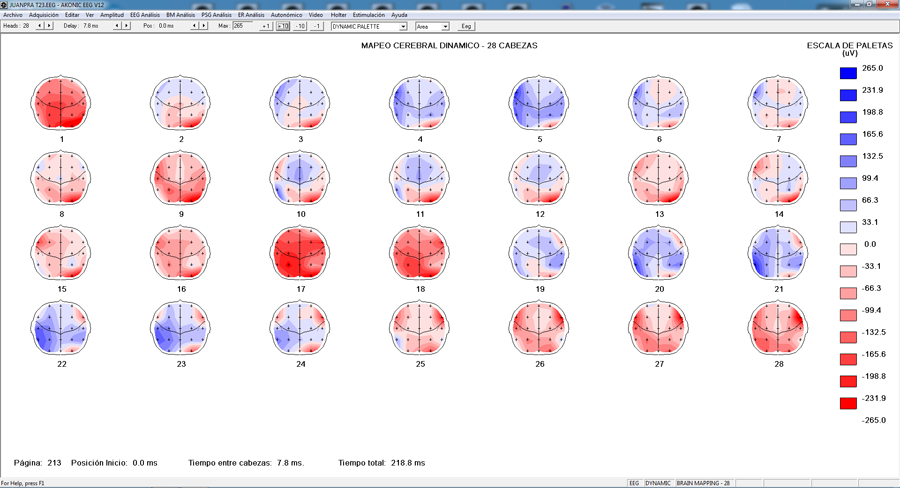
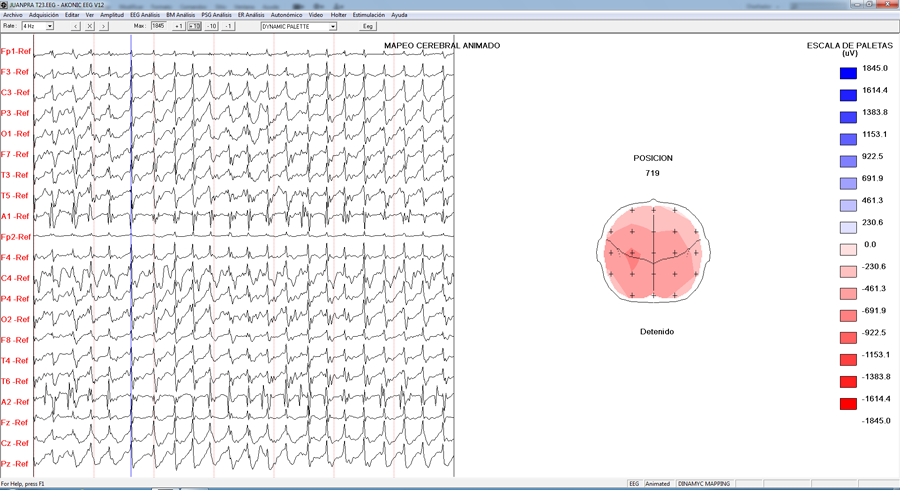
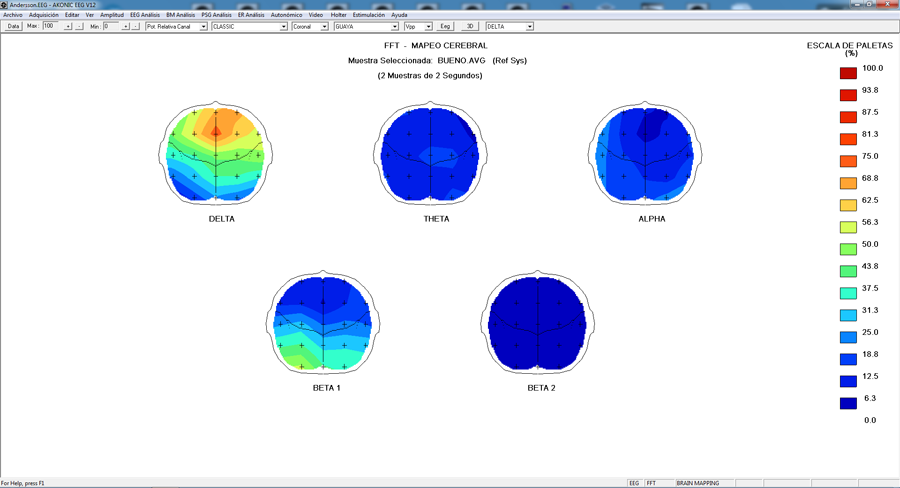
Polysomnography Software V12
Polysomnography Software V12 (PSG V12) is Windows based software for data acquisition, analysis and reporting. Their characteristics are:
Required operating system:
- Windows XP/Seven/Windows 8.
Required hardware:
- NeuroTrace™ system. BIO-PC™ system.
Optional:
- Cerebral Topographic Mapping V12.Video EEG/PSG.Encephalographic Holter.
Software Features:
- Quick menus and easy review of the study. User-defined patient status and comments. Cursor for measurement of amplitudes, peak-to-peak voltage, initial voltage, time, and frequency. High and low frequency channel-by-channel post-processing digital filters. Paging and seconds per page controlled by software during record review. Visual stimulation and auditory stimulation. Automatic or manual PSG analysis. Body position sensor, ambient light sensor and serial oximeter.Piezoelectric respiratory effort sensors.Online impedance test.Unlimited number of user-configurable assemblies.Monopolar, referential and bipolar reconstruction.Automatic conversion to ASCII and EDF formats.High quality printing with all types of printer.Online help.User manual presented in .pdf format.
Technical specifications:
- A/D resolution: 16 bits. Safety tokens and connector for eletrocap. Number of channels: 21 EEG/EOG channels (up to 64 channels), 1 airflow channel (thermistor or pressure sensor), 2 stress channels respiratory devices, 6 ground inputs, 4 digital display channels and 2 DC auxiliary inputs (oximetry, pH, CPAP pressure, etc.).
Photostimulator:
- Lamp or Super Light Diods (SLD). Optional: SLDW and wireless photostimulator with rechargeable batteries. Software-controlled stimulation frequency: 0.5 to 30 Hz and manual.
Audioestimulador:
- Click or tone (BIO-PC). Intensities and durations controlled by software.

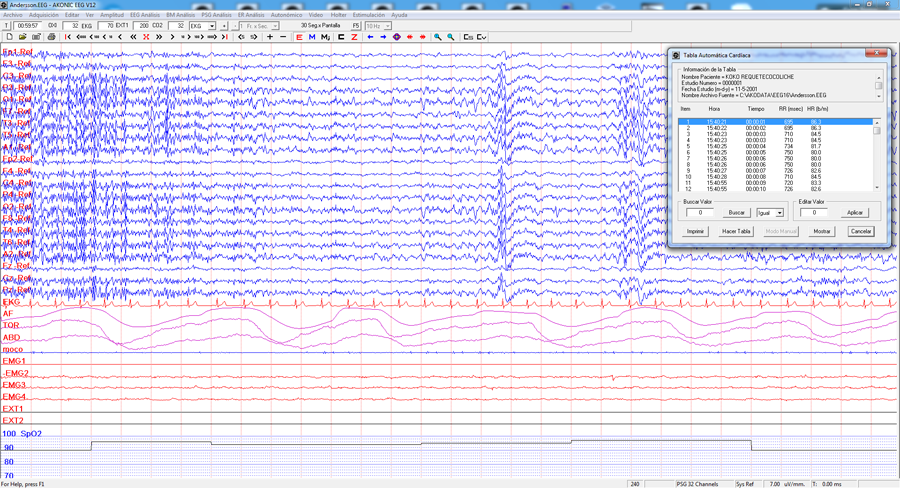
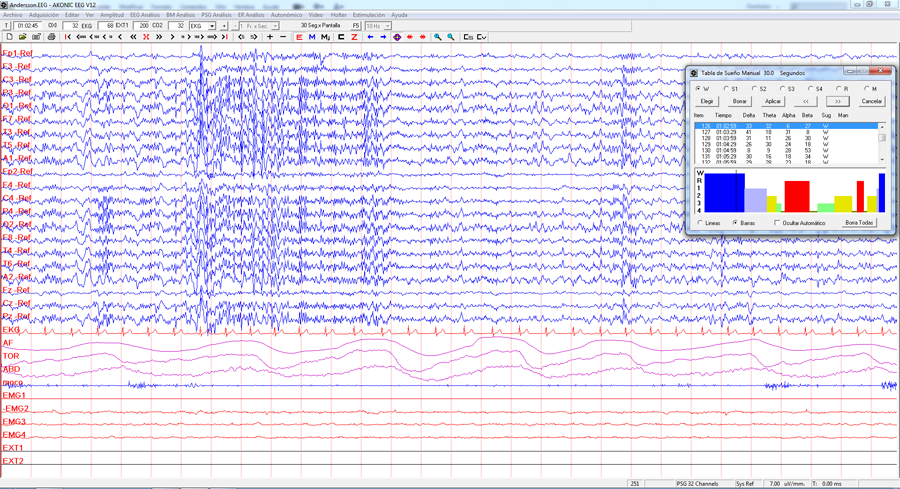
Available applications:
- Topographic brain mapping (qEEG).FFT analysis.Video digital monitoring of EEG/PSG.Event related potentials.Evoked potentials.Electromyography.Steady state.Electronystagmography.EEG ambulatory Holter.
EEG Software V11
Electroencephalography Software V11 (EEG V11) is Windows based software for data acquisition, analysis and reporting. Their characteristics are:
Required operating system:
- Windows XP/Seven/Windows 8.
Required hardware:
- NeuroTrace™ system (1020 system). BIO-PC™ system (1020-1010 system with 64 channels).
Optional:
- Cerebral topographic mapping V11.Video EEG/PSG V11.
Software Features:
- Quick menus and easy review of the study. User-defined patient status and comments. Cursor for measurement of amplitudes, peak-to-peak voltage, initial voltage, time, and frequency. High and low frequency channel-by-channel post-processing digital filters. Paging and seconds per page controlled by software during record review. Visual stimulation and auditory stimulation. Automatic or manual PSG analysis. Body position sensor, ambient light sensor and serial oximeter.Piezoelectric respiratory effort sensors.Online impedance test.Unlimited number of user-configurable assemblies.Monopolar, referential and bipolar reconstruction.Automatic conversion to ASCII and EDF formats.High quality printing with all types of printer.Online help.User manual presented in .pdf format.
Technical specifications:
- A/D resolution: 16 bits. Safety tokens and connector for eletrocap. Number of channels: 21 EEG/EOG channels (up to 64 channels), 1 airflow channel (thermistor or pressure sensor), 2 stress channels respiratory devices, 6 ground inputs, 4 digital display channels and 2 DC auxiliary inputs (oximetry, pH, CPAP pressure, etc.).
Photostimulator:
- Super Light Diods (SLD).Optional: SLDW and wireless photostimulator with rechargeable batteries.Software controlled stimulation frequency: 0.5 to 30 Hz and manual.
Audioestimulador:
- Click or tone (BIO-PC). Intensities and durations controlled by software.
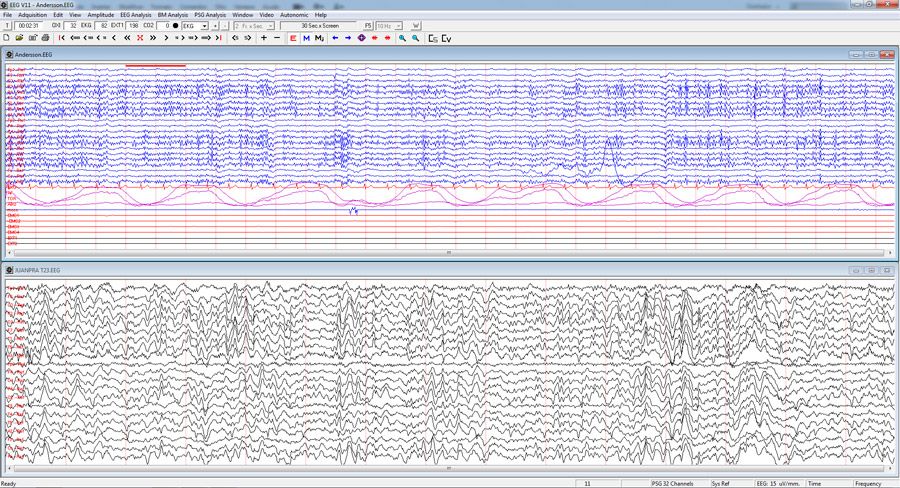
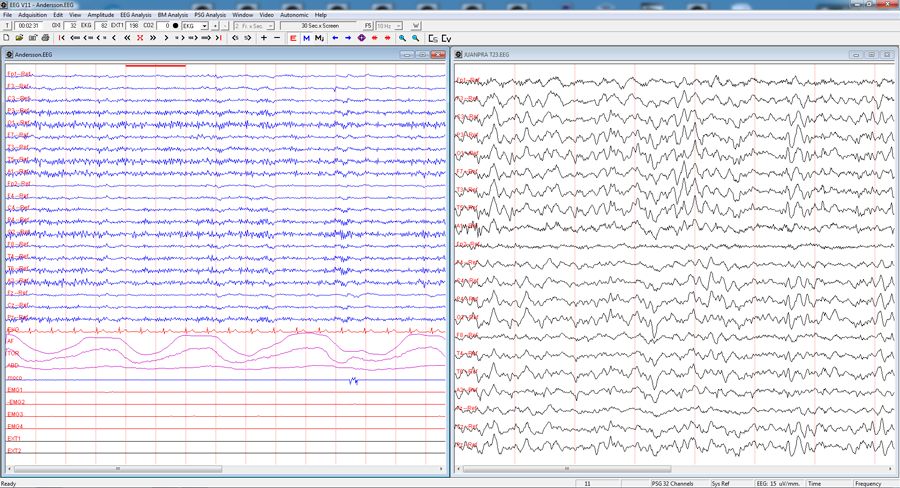
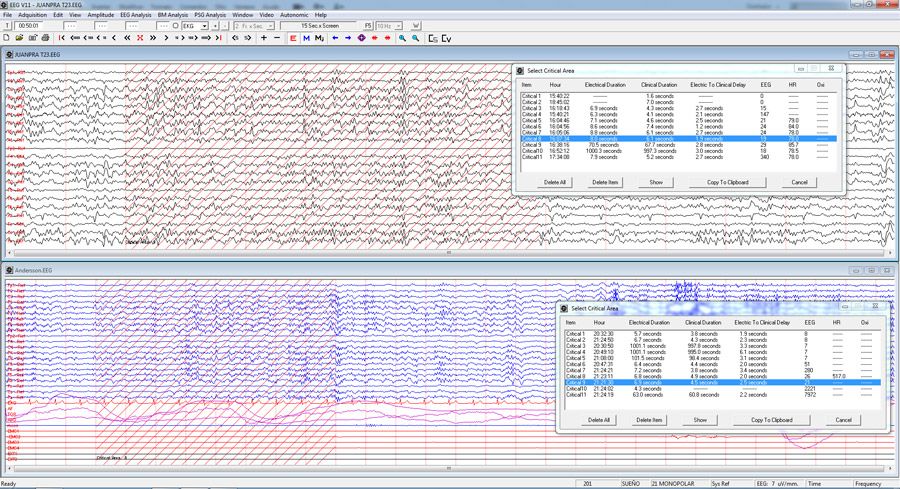
Available applications:
Topographic brain mapping (qEEG).
FFT analysis.
Digital video monitoring of EEG/PSG.
Event related potentials.
Evoked potentials.
electromyography.
Steady state.
Electronystagmography.
Ambulatory Holter EEG.
You can download the brochure by clicking here.
Topographic Brain Mapping Software V11
V11 Topographic Brain Mapping Software is Windows based software for data acquisition, analysis and reporting. Their characteristics are:
Required operating system:
- Windows XP/Seven/Windows 8.
Required hardware:
- NeuroTrace™ system. BIO-PC™ system.
Required software:
- Software EEG V11.
Software Features:
- Maps, numerical data and frequency spectra (histograms) in five possible scales:
absolute power.
Relative power per band.
Relative power per channel.
Relative amplitude per channel.
Asymmetry.
- Dynamic mapping for epilepsy (up to 28 maps). Animated mapping. Fourier mapping. Spectral power. Interelectrode brain coherence. Interhemispheric brain coherence. Sample comparison. Z-score analysis with selection of standard deviation. Detection of sharp waves. Comparison between patients and medications. User selectable bands. User selectable palettes. User selectable histograms. 1 - 2 second samples. Sample averaging.
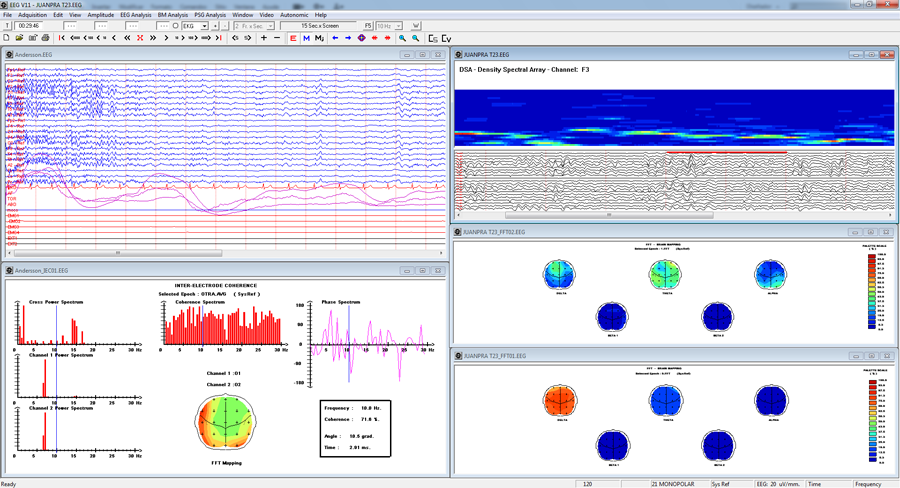
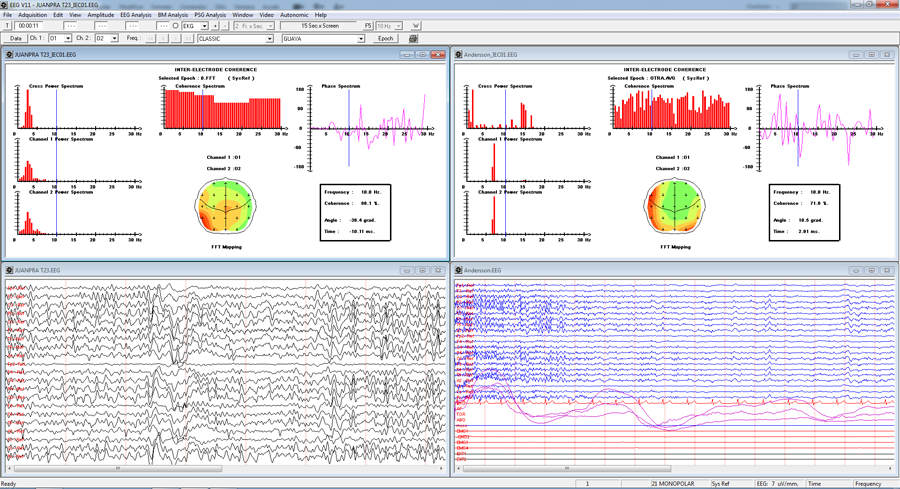
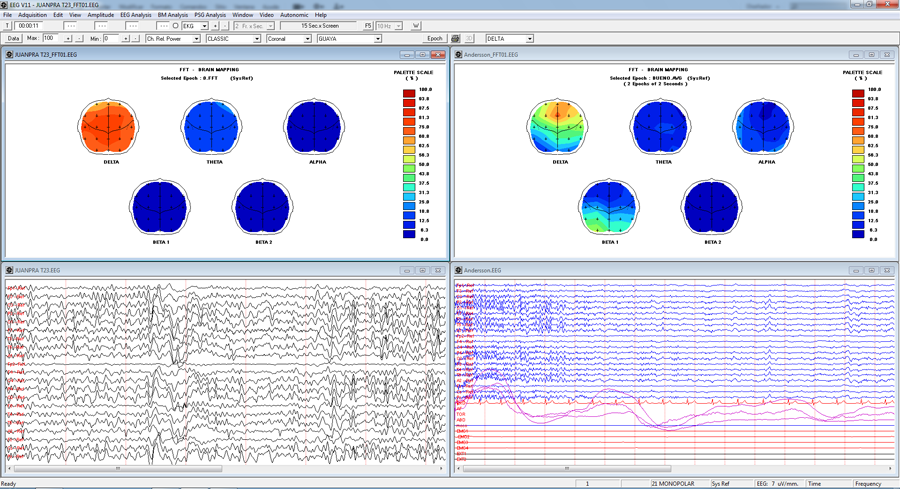
Polysomnography Software V11
Polysomnography Software V11 (PSG V11) is Windows based software for data acquisition, analysis and reporting. Their characteristics are:
Required operating system:
- Windows XP/Seven/Windows 8.
Required hardware:
- NeuroTrace™ system. BIO-PC™ system.
Optional:
- Brain topographic mapping V11.Video EEG/PSG.
Software Features:
- Quick menus and easy review of the study. User-defined patient status and comments. Cursor for measurement of amplitudes, peak-to-peak voltage, initial voltage, time, and frequency. High and low frequency channel-by-channel post-processing digital filters. Paging and seconds per page controlled by software during record review. Visual stimulation and auditory stimulation. Automatic or manual PSG analysis. Body position sensor, ambient light sensor and serial oximeter.Piezoelectric respiratory effort sensors.Online impedance test.Unlimited number of user-configurable assemblies.Monopolar, referential and bipolar reconstruction.Automatic conversion to ASCII and EDF formats.High quality printing with all types of printers. Online help.
User manual presented in .pdf format.
Technical specifications:
- A/D resolution: 16 bits. Safety tokens and connector for eletrocap. Number of channels: 21 EEG/EOG channels (up to 64 channels), 1 airflow channel (thermistor or pressure sensor), 2 stress channels respiratory devices, 6 ground inputs, 4 digital display channels and 2 DC auxiliary inputs (oximetry, pH, CPAP pressure, etc.).
Photostimulator:
- Super Light Diods (SLD).Optional: SLDW and wireless photostimulator with rechargeable batteries.Software controlled stimulation frequency: 0.5 to 30 Hz and manual.
Audioestimulador:
- Click or tone (BIO-PC). Intensities and durations controlled by software.
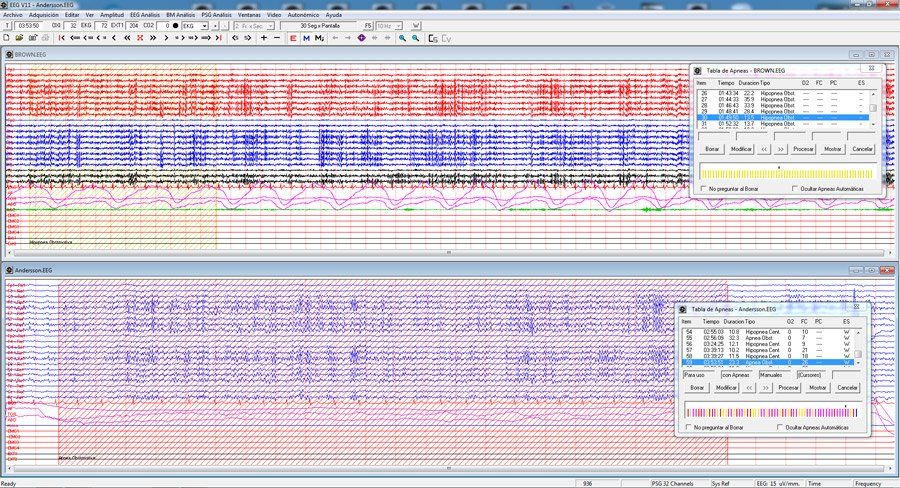
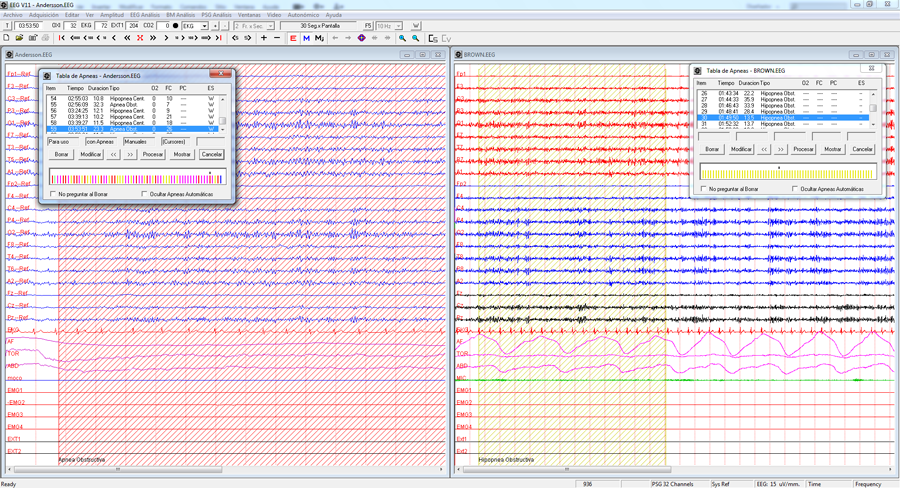
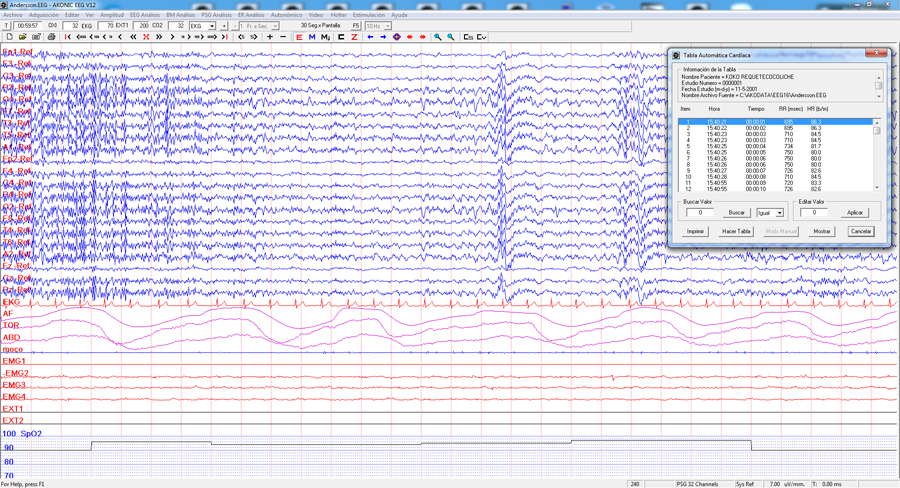
Available applications:
- Topographic brain mapping (qEEG).FFT analysis.Video digital monitoring of EEG/PSG.Event related potentials.Evoked potentials.Electromyography.Steady state.Electronystagmography.EEG ambulatory Holter.
Software the video EEG / PSG V11 / V12
EEG / PSG V11 / V12 video software is Windows based multimedia software. Their characteristics are:
Required operating system:
- Windows XP/Seven/Windows 8.
Software Features:
- Presentation 1: in the video window. Presentation 2: on top of the layout. Frames of different sizes, expandable by the user. Frame-by-frame or continuous review. Quick video position control (beginning, end, and slider). Continuous full video review. Perfect synchronization with the studio. Selectable number of frames per second. Review at different speeds. Independent video files per page. Video recording with or without sound. Hard drive dependent capacity. Automatic review and manual.Cursor for video frame selection.Zoom, focus and movement in xyz axis by software.Video review by network.Video editable by standard programs.
